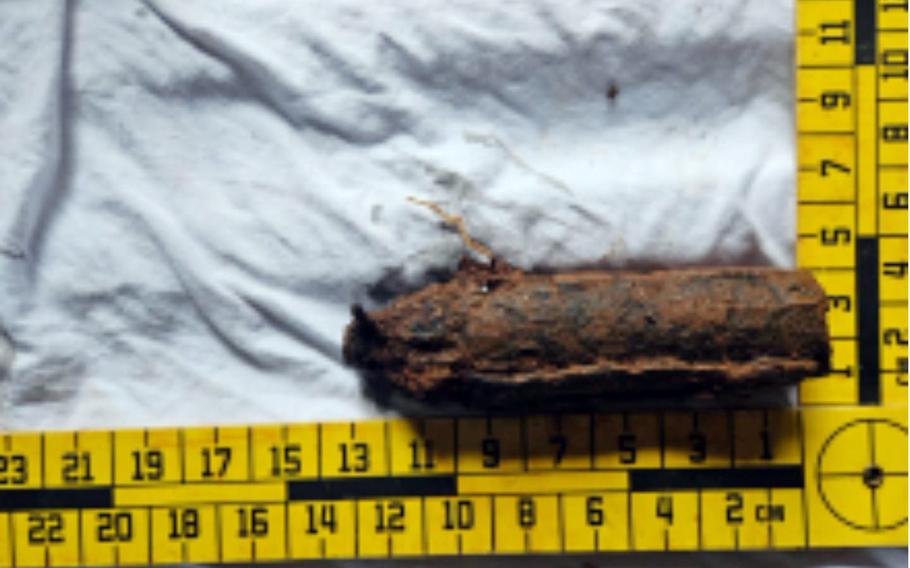
A three-man EOD team with 36th Civil Engineer Squadron removed and detonated a U.S. bomb base fuse and two 20 mm shells found at Andersen Air Force Base, Guam, Oct. 2, 2024. (U.S. Air Force)
Explosive ordnance technicians on Guam recently removed and detonated a U.S. bomb base fuse and two unexploded shells apparently left over from World War II.
The unexploded ordnance was discovered around 1 p.m. Oct. 2 in the South Finegayan section of Andersen Air Force Base, on the southwest side of the Army’s Task Force Talon area, the 36th Wing said Tuesday in an unsigned email.
A three-man EOD team with the 36th Civil Engineer Squadron led by Staff Sgt. Austin Denton removed the base fuse and the two 20 mm shells and detonated them on the EOD range in Tarague, Tech. Sgt. Adam McMillen, EOD operations and training section chief, wrote in a follow-up email Wednesday.
The ordnance was identified as an AN-M102A1 base fuse and two “Mk 3 Mod 25 20mm HE projectiles” by 36th Wing commander Brig. Gen. Thomas Palenske in a Sunday post on his Facebook page.
The base fuse would have been installed in the tail end of either a 500- or 1,000-pound bomb dropped by a B-24 Liberator heavy bomber during World War II, McMillen wrote.
The shells “were likely fired from an Oerlikon Anti-Aircraft gun on one of the Naval vessels in the area providing close-in air defense for the Marines taking the island” during fighting on Guam in World War II, he added.
“Purely conjecture, but the sailors manning those guns may have trained them toward enemy positions on the ground,” McMillen wrote. “If I had to guess how those rounds got where they did, I find that scenario more likely than a round went up to max height, duded, then came all the way back down and landed on the island.”
The ordnance was found by “a Task Force Talon member walking around the building,” the wing wrote Tuesday.
Due to the large amount of unexploded ordnance on the island left over from two battles in WWII, special clearances are required for any construction projects on Andersen or North West Field. The area west of the Task Force Talon is being swept to expand the Army’s site, McMillen wrote.
“They find UXOs like this as often as every day, or sometimes not at all,” he wrote. “A lot of the variability in that is explained by the locations of Japanese strongholds on the island in 1944, those were targeted by Naval artillery barrages and some of those artillery rounds did not explode as intended. If a dig site is near one of those locations, it is more likely to find UXO.”
The first battle of Guam took place Dec. 8-10, 1941. A small, lightly armed garrison of sailors and Marines was overrun by a larger Japanese landing force, and Japan took over the island just a week after the attack on Pearl Harbor.
The second battle of Guam, from July 21 to Aug. 10, 1944, was part of a larger island campaign, Operation Forager. Approximately 59,000 U.S. service members and many native Chamorros faced about 18,000 Japanese.
About 3,000 U.S. troops were killed. While the battle officially ended Aug. 10, some 7,500 Japanese troops remained on the island. The last, Sgt. Shoichi Yokoi, was discovered on Jan. 24, 1972.